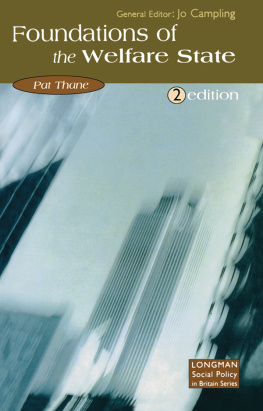The University of Chicago Press, Chicago 60637
The University of Chicago Press, Ltd., London
2020 by Edward D. Berkowitz
All rights reserved. No part of this book may be used or reproduced in any manner whatsoever without written permission, except in the case of brief quotations in critical articles and reviews. For more information, contact the University of Chicago Press, 1427 E. 60th St., Chicago, IL 60637.
Published 2020
Printed in the United States of America
29 28 27 26 25 24 23 22 21 20 1 2 3 4 5
ISBN -13: 978-0-226-69206-7 (cloth)
ISBN -13: 978-0-226-69223-4 (paper)
ISBN -13: 978-0-226-69237-1 (e-book)
DOI : https://doi.org/10.7208/chicago/9780226692371.001.0001
Library of Congress Cataloging-in-Publication Data
Names: Berkowitz, Edward D., author.
Title: Making social welfare policy in America : three case studies since 1950 / Edward D. Berkowitz.
Description: Chicago : University of Chicago Press, 2020. | Includes bibliographical references and index.
Identifiers: LCCN 2019035397 | ISBN 9780226692067 (cloth) | ISBN 9780226692234 (paperback) | ISBN 9780226692371 (ebook)
Subjects: LCSH : Public welfareUnited StatesHistory20th century. | Disability insuranceUnited StatesHistory20th century. | MedicareHistory20th century. | Aid to families with dependent children programsUnited StatesHistory20th century.
Classification: LCC HV 91 . B 395 2020 | DDC 361.6/10973dc23
LC record available at https://lccn.loc.gov/2019035397

This paper meets the requirements of ANSI/NISO Z 39.48-1992 (Permanence of Paper).
For much of my adult life I have studied the history of social welfare programs, and this book marks, so far as I know, my final effort in the field. Since this book depends so heavily on what I have written before, it might be worthwhile to describe briefly my past projects that have informed this one. My interest in the field of social welfare policy probably comes from my father, who spent his long academic career studying workers compensation and other disability programs. When it came time for me to write a dissertation in my chosen field of history, I picked the topic of the vocational rehabilitation program, a little-studied federal-state program that offers counseling and other services to people with disabilities. As if to bring things full circle, the vocational rehabilitation program figures in this book as well.
Nothing about this circular path reflects conscious planning on my part. As a member of a cohort of historians who have always worked in an uncertain academic market, I have drifted from one project to anothermostly in response to someone asking me to write something. This book contains three case studies that concern programs I have considered over the course of my career. This book, in other words, derives from my previous ones and uses research I have done in the course of writing those books. If there is something new here, it consists of my desire not only to chronicle the passage of legislation but also to figure out what happened to the programs after they were launched. Each of the programs developed in a different way that perhaps illustrates something about the expansion of Americas welfare state after the founding eras of the New Deal and the Great Society.
I began my academic career by writing a book with a friend from graduate school. Sympathetic advisors advised us against the project and counseled that published versions of our respective dissertations should come first. We persisted, in my case because I had nothing better to do. When an editor for a prestigious academic press approached us at an academic conference and asked whether we had a book manuscript, it was as close to a commission as we were likely to get. The resulting book had the usual travails. The prestigious press rejected it after receiving what I remember as three negative reports. Part of the problem might have been that, in our ignorance of the rules of academic publishing, we sent the manuscript to the publisher without including footnotes. The readers could not find themselves in the text. We remedied the problem, and in 1980 a marginal press published the book. Within the very small realm of social welfare history, the book acquired a niche because it fit into the literature being developed by Harvard professor Theda Skocpol and her associates on the development of Americas welfare state.
That began an academic career that included stints at the University of Massachusetts Boston where white working-class students interested in accounting met Marxist professors and other harbingers of a radical change that never quite reached the students in South Boston and Dorchester. I next worked on the staff of a presidential commission in Washington, increasing my interest in public policy, then in an office at Brandeis University devoted to fundraising, where I got to pitch Brandeis to bored executives at the Gillette Company in Boston and the Chemical Bank on Wall Street, before landing at George Washington University, where I spent the rest of my career.
In these various locations, I encountered the three social welfare programs that form the case studies in this book. My first choice was a program that Congress legislated in 1956 that contemporaries referred to most often as SSDI (Social Security Disability Insurance). It extended the Social Security program, created in 1935, so that people with disabilities could receive retirement benefits before reaching the normal retirement age. I first encountered the program when I wrote my doctoral dissertation on the history of disability programs, and it became a recurring interest. When I came to George Washington University, I needed a scholarly project, and a grant from the Twentieth Century Fund allowed me to pursue my research on disability programs in conditions of relative comfort. Disabled Policy (1987) marked one of my first self-conscious attempts to use history to illuminate contemporary developments in public policy.
Medicare, created in 1965 at the height of the Great Society, serves as my second case study. This program is another that has come up repeatedly in the course of my career. I first seriously encountered it when I wrote a biography of Social Security bureaucrat Wilbur Cohen, Mr. Social Security (1987). Writing that book brought me into contact with Wilbur Joseph Cohen, one of the frontline bureaucrats who worked on Social Security, increasing my respect for the competence of these government employees and my appreciation of their influence. I also dug into Medicare archives in places like the Wisconsin Historical Society and the Lyndon Baines Johnson Presidential Library. Somewhere along the way I met Martha Derthick, whose book Policymaking for Social Security (1979) is the most perfect blend of history and public policy I have ever encountered. Both Martha Derthick and Wilbur Cohen reinforced the importance of considering public administration in the study of social welfare programs. So did Robert Ball, the Social Security administrator who implemented the Medicare program, whose biography I published in 2003.
I had other opportunities to study Medicare as a Robert Wood Johnson Foundation Faculty Fellow in Health Care Finance at Johns Hopkins (19871988) and as a commissioned author of histories of the Group Health Association in Washington, DC (1988), and of the National Academy of Sciences Institute of Medicine (1998). Later I had a chance to do interviews for the Health Care Financing Administration, the National Libraries of Medicine, and the National Academy of Social Insurance with many of the key administrators and researchers in Medicare and health care services (all of which are available on the internet). Each of these oral history projects came to me over the transom, so to speak, and not as part of a conscious plan to learn about the history of Medicare.
 This paper meets the requirements of ANSI/NISO Z 39.48-1992 (Permanence of Paper).
This paper meets the requirements of ANSI/NISO Z 39.48-1992 (Permanence of Paper).







